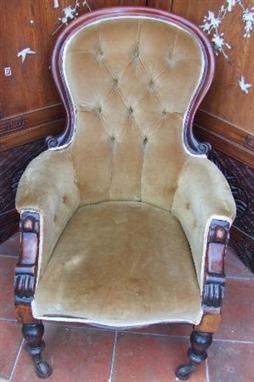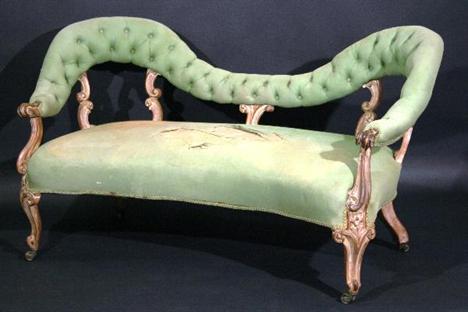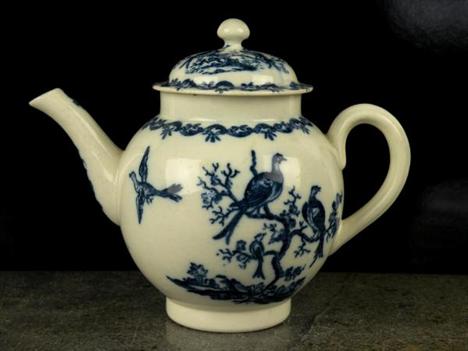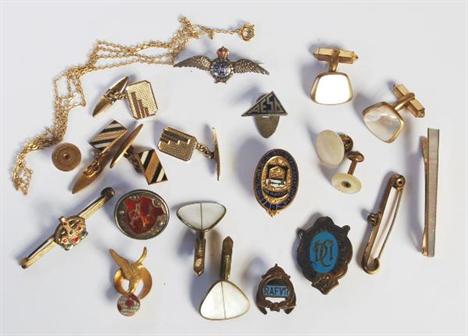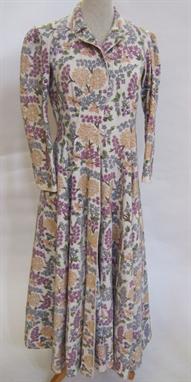We found 110990 price guide item(s) matching your search
There are 110990 lots that match your search criteria. Subscribe now to get instant access to the full price guide service.
Click here to subscribe- List
- Grid
-
110990 item(s)/page
An 18ct gold hunting cased centre seconds chronograph watch, three quarter plate, keyless lever movement signed H. Skinner, 120 Parade, Leamington, no. 21584; white enamel dial with subsidiary seconds and 60 minute recorder at 12 o` clock, in a case with button in the band, engraved armorial and reverse with monogram, London 1881, 52mm dia.
A Caughley custard cup and cover, circa 1780-85, the bell shaped body with stand off loop handle, printed in blue with the Willow Nankin pattern, the cover with associated post and dagger border and button knop, Sx in blue to base, bearing `The Lloyd Collection label no. 117` (at fault) 7.8cm high See C & W P plate 111, for a selection of three Caughley custard cups, the example in the centre being a similar Willow Nankin pattern. See also CBE catalogue no. 412 for a very similar custard cup and cover.
A Caughley custard cup and cover, circa 1785-90, the bell shaped body with loop handle, printed in blue with the Cottage pattern within cell borders, the cover with plain button knop (at fault) 7.5cm high See C & W P plate 111 and also CBE catalogue no. 256 for similar custard cups and cover. See also Phillips London, The Watney Collection part I, 22nd September 1999, lot 428, for a similar example.
Early Victorian gentlemens` silver pair cased pocket watch with white enamel dial decorated with landscape depicting farmer ploughing field, the fusée movement with verge escapement by Crundwell, Hadow, cases and movement both numbered 37749, hallmarked London 1856 Excellent condition. Dial perfect. Case excellent. Push button on outer case worn away. Fusée chain intact balance wheel spins freely. The watch winds but does not run.
A ladies Art Deco diamond set cocktail watch, a circular silvered dial with black Arabic numerals and blued hands, to an oval case, milligrain set with graduated eight cut diamonds. Hand engraved case sides and cabochon button to a fine mesh link bracelet with adjustable slide, signed Albion. Bracelet marked 9ct and tested as approximately 9ct white gold. The outer case tested as platinum with 18ct yellow gold interior sides
An Edwardian silver double ended mounted blue glass scent bottle, by Heath & Middleton, Birmingham 1907, 10.25cm long, and two silver plated mounted green/cranberry glass examples, 10 and 8.5cm long respectively, two silver propelling pencils, one by S Morden & Company, a silver button hook, a silver and mother of pearl folding fruit knife, an Indian silver pepper, and a Railways Athletic Associations medal (9)
David Martin (1737-1798) PORTRAIT OF CAPTAIN CHARLES KERR OF CALDERBANK (1753-1813), THREE-QUARTER LENGTH STANDING, leaning on his rifle, wearing the uniform of The Royal Edinburgh Volunteers, with an estuary and castle in the background , Oil on canvas , 129 x 102cm. Provenance: by descent in the Kerr family. Exhibited: on loan to the National War Museum (formerly Scottish Naval and Military Museum), Edinburgh Castle, 1936-1994. Charles spent some time in Holland and London with a view to a commercial life, but resolved instead to be a soldier. He joined the 43rd Regiment as a subaltern, sailed for Boston, fought through the American War of Independence and was wounded at Bunker Hill; on his return to England he became a captain by purchase. Retiring from the army, he became a captain of grenadiers in the first regiment of Royal Edinburgh Volunteers, joint King`s printer for Scotland, along with a cousin, Alexander Kincaid. He is buried in the Greyfriars Churchyard in Edinburgh, near to his wife Marion Sharp and many of his family. Captain Charles Kerr was one of the original officers in the Royal Edinburgh Volunteers. The Volunteers were embodied on 3rd July 1794, when a general meeting of the members was held in the Sheriff Court Rooms when certain leading articles of regulation were established, and a committee of management appointed. The Volunteers were to bear all their own expenses of clothing and other necessaries; and half-a-guinea of entry money was exacted from each member towards defraying contingencies. Subsequently, however, on application to Government, the usual pay was obtained for an adjutant; pay and clothing for a sergeant-major and twenty sergeants; and also for twelve drummers and twelve pipers. The entire scheme of embodying the citizens as volunteers, it is said, was solely projected by the late James Laing, Deputy City Clerk. The uniform was described to consist of a blue coat, with a red cape and cuff, white lining turned up in the skirts, two gold epaulettes, and a button bearing the name of the corps and arms of the city; white cashmere vest and breeches, and white cotton stockings; short gaiters of black cloth; a round hat, with two black feathers and one white. The belts of the Edinburgh Volunteers were painted white, which soon gave the corps an awkward appearance on account of the paint scaling off, and leaving portions of white and black alternatively. They were accordingly soon laid aside, and the common buff belt substituted. The regiment, being assembled in Heriot`s Green on the 26th September 1794, was presented with a stand of colours by the Lord Provost (Sir James Stirling), attended by the two senior Magistrates, the Principal of the University, and the whole Members of the Town Council, in their robes. The colours were very handsome: the one elegantly embroidered with a crown, and the letters G. R.; and the other with the City Arms. A vast crowd of spectators attended to witness the presentation. The 43rd (Monmouthshire) Regiment of Foot was an infantry Regiment of the British Army. It was raised as Thomas Fowke`s Regiment of Foot in 1741, renamed the 54th Regiment of Foot in 1747, and became the 43rd Foot in 1751. The Regiment saw action in the Americas during the 1770s and 1780s. Charles Kerr is listed as a bookseller and printer in the Edinburgh Directory and became His Majesty`s Printer for Scotland. The island in the background could be Inchgarvie Island in the Firth of Forth. Martin was a pupil of Allan Ramsay from 1752; in 1755 he joined Ramsay in Rome, where he remained for over a year, studying under the patronage of Robert Alexander, an Edinburgh banker. On Ramsay`s return to Britain, Martin worked for him in London until 1775, painting most of the drapery work for him during the early and middle 1760s. By 1766, when he engraved Ramsay`s portrait of Jean Jacques Rousseau, he was earning over £300 a year as assistant and copyist. He began his independent practice while still engaged in Ramsay`s studio and his finest early portrait is that of Benjamin Franklin in 1767; it is informal and intimate, and it was described by Horace Walpole as `a great likeness`. Although Martin`s preferred format was three-quarter length, in the late 1770s he attempted full-lengths of Henry, 2nd Earl Bathurst and William, 1st Earl of Mansfield. We wish to thank Stuart Allan, Senior Curator of Military History, National War Museum, Edinburgh. Confirmation that this was on loan to the NWM.
-
110990 item(s)/page












